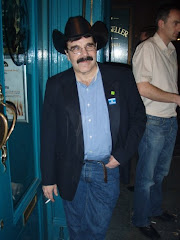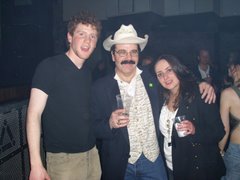Republican Politics, American Style
Published on May 3rd 2007 in Metro Eireann
By Charles Laffiteau
The US Ambassador to Ireland, Thomas Foley recently spoke to students at Dublin City University (DCU) about what the United States is doing to address concerns about climate change due to global warming. I must say that I admire the Ambassador for his willingness to discuss this issue and field questions about Bush administration policies from an audience that he knew would be less than sympathetic.
While I think Ambassador Foley did a good job of framing the problem, I don’t think he made as much headway in terms of persuading the audience that the Bush administration was very concerned about this issue. It isn’t easy to defend the steps the Bush administration has taken to reduce US green house gas emissions when these proposals simply do not square with the view that President Bush sees this as a serious problem.
To find out precisely what those steps are, you can access President Bush’s environmental proposals on the web at www.whitehouse.gov. Be forewarned that you will have to do a bit of searching once you get there though. On the White House home page you will have to click on “other issues” at the end of an IN FOCUS issues column of 15 categories including Immigration, Iraq, Pandemic Flu and the Patriot Act. Mind you, these are also important issues, but you nonetheless get a sense that the environment isn’t exactly a top Bush administration priority.
This feeling is reinforced when you get to the “other issues” page which highlights President Bush’s judicial nominations and efforts to strengthen social security. But if you will ignore this and look in the right hand column under “Policies and Initiatives” there is an alphabetical listing which includes one on Environment. Click on this and the next page will highlight the President’s US National Parks Centennial Initiative.
Now don’t get discouraged. If you will look very carefully in the right hand column under the “Documents” heading, in the smallest print on the page, you will find a listing for “Global Climate Change Policy Book”. Click on this and you will find out exactly what the Bush administration proposes to do to address global climate change. In the Executive Summary President Bush says: "Addressing global climate change will require a sustained effort, over many generations. My approach recognizes that sustained economic growth is the solution, not the problem – because a nation that grows its economy is a nation that can afford investments in efficiency, new technologies, and a cleaner environment." In other words, the solution to solving the problem of global warming is to keep consuming energy and growing economically, while we wait for new affordable technologies to be developed.
President Bush goes on to state that: “The policy challenge is to act in a serious and sensible way, given the limits of our knowledge. While scientific uncertainties remain, we can begin now to address the factors that contribute to climate change." Note the President’s use of the phrase: “While scientific uncertainties remain” as regards the effects of green house gas emissions on climate change.
This statement underlines Bush administration officials’ efforts to censor statements and scientific reports by the US Government’s own climate scientists regarding the reality of global warming and what is causing it. Unfortunately, the Bush administration has a track record of removing “uncertainties” (as it did with highly questionable rumours and intelligence reports of WMDs and al-Qaeda’s pre-war presence in Iraq) or injecting them (as Philip Cooney did in his editing of government scientists’ climate reports over several years) to justify the Bush administration’s actions or inaction on various issues.
Mr. Cooney, the former chief of staff of the White House Council on Environmental Quality, was the “climate team leader” for the American Petroleum Institute (the main oil industry lobby) before he joined the White House staff. He was subsequently hired by Exxon Mobil after he resigned his White House position in 2005. Mr. Cooney, who has no scientific background, said he had based his changes to climate science reports on the “most authoritative and current views of the state of scientific knowledge”, yet was unable to identify who these authoritative sources of scientific knowledge were. Oil company scientists no doubt.
On the other hand, the US space agency, NASA’s top climate scientist, Dr. James Hansen protested this editing by Mr. Cooney, calling it censorship of US government scientific reports. He cited this and efforts by other Bush political appointees to limit scientists access to the news media as attempts to “muddy the waters” of the US public debate about global warming and climate change issues.
While Ambassador Foley privately acknowledged that this may have been true a couple of years ago, he truly seems to believe that this is no longer the case. I think the Ambassador honestly feels that no one in the Bush administration is still questioning whether or not climate change due to global warming is really happening. I hope his assessment is accurate even though one might still doubt this given the fact that the Global Climate Change Policy Book still references “scientific uncertainties”.
There is also other evidence to suggest that the Bush administration still doesn’t get it. Just last month the US Supreme Court ruled that the Environmental Protection Agency (EPA) has the authority to regulate heat-trapping gases in automobile emissions. This decision represented a strong reprimand to the Bush administration, which had argued that it does not have the right to regulate carbon dioxide and other heat-trapping gases under the Clean Air Act, and that even if it did, it would not use the authority.
Justice John Paul Stevens wrote the majority opinion which stated that; “The statutory text forecloses EPA’s reading,” adding that “greenhouse gases fit well within the Clean Air Act’s capacious definition of air pollutant.” Even more damning was the Supreme Court’s assessment of the Bush administration’s justification for not regulating such pollutants. The Justices were very critical of the Bush administration’s defence of its position, stating that it amounted to nothing more than a “laundry list of reasons not to regulate.” The Court went on to state that Bush’s political appointees running the EPA had defied the Clean Air Act’s “clear statutory command,” to regulate green house gas emissions.
Given all of the aforementioned examples, one cannot help but question President Bush’s “real” concerns about climate change and the Bush administration’s position that it is actively working to address this issue. If the US Supreme Court doesn’t buy these contentions, why should I?
Next week I will discuss some of the specific issues Ambassador Foley highlighted during his attempt to make a case for President Bush’s proposals on what the US is doing to address the problem of climate change.
Monday, May 7, 2007
Subscribe to:
Post Comments (Atom)



No comments:
Post a Comment